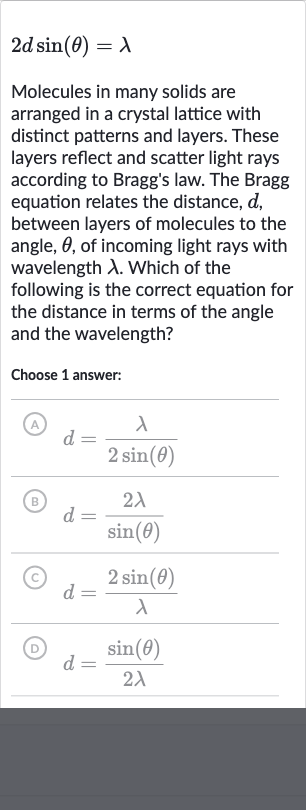AI tutor
Welcome to Bytelearn!
Let’s check out your problem:

Molecules in many solids are arranged in a crystal lattice with distinct patterns and layers. These layers reflect and scatter light rays according to Bragg's law. The Bragg equation relates the distance, , between layers of molecules to the angle, , of incoming light rays with wavelength . Which of the following is the correct equation for the distance in terms of the angle and the wavelength?Choose answer:(A) (B) (C) (D)
Full solution
Q. Molecules in many solids are arranged in a crystal lattice with distinct patterns and layers. These layers reflect and scatter light rays according to Bragg's law. The Bragg equation relates the distance, , between layers of molecules to the angle, , of incoming light rays with wavelength . Which of the following is the correct equation for the distance in terms of the angle and the wavelength?Choose answer:(A) (B) (C) (D)
- Isolate : The given equation is . To find the distance in terms of and , we need to solve for .
- Divide by : Divide both sides of the equation by to isolate on one side:
- Final equation for d: The correct equation for the distance in terms of the angle and the wavelength is therefore , which corresponds to option (A).
More problems from Write equations of cosine functions using properties
QuestionGet tutor help
QuestionGet tutor help
QuestionGet tutor help
QuestionGet tutor help
QuestionGet tutor help
QuestionGet tutor help
QuestionGet tutor help
QuestionGet tutor help
QuestionGet tutor help
